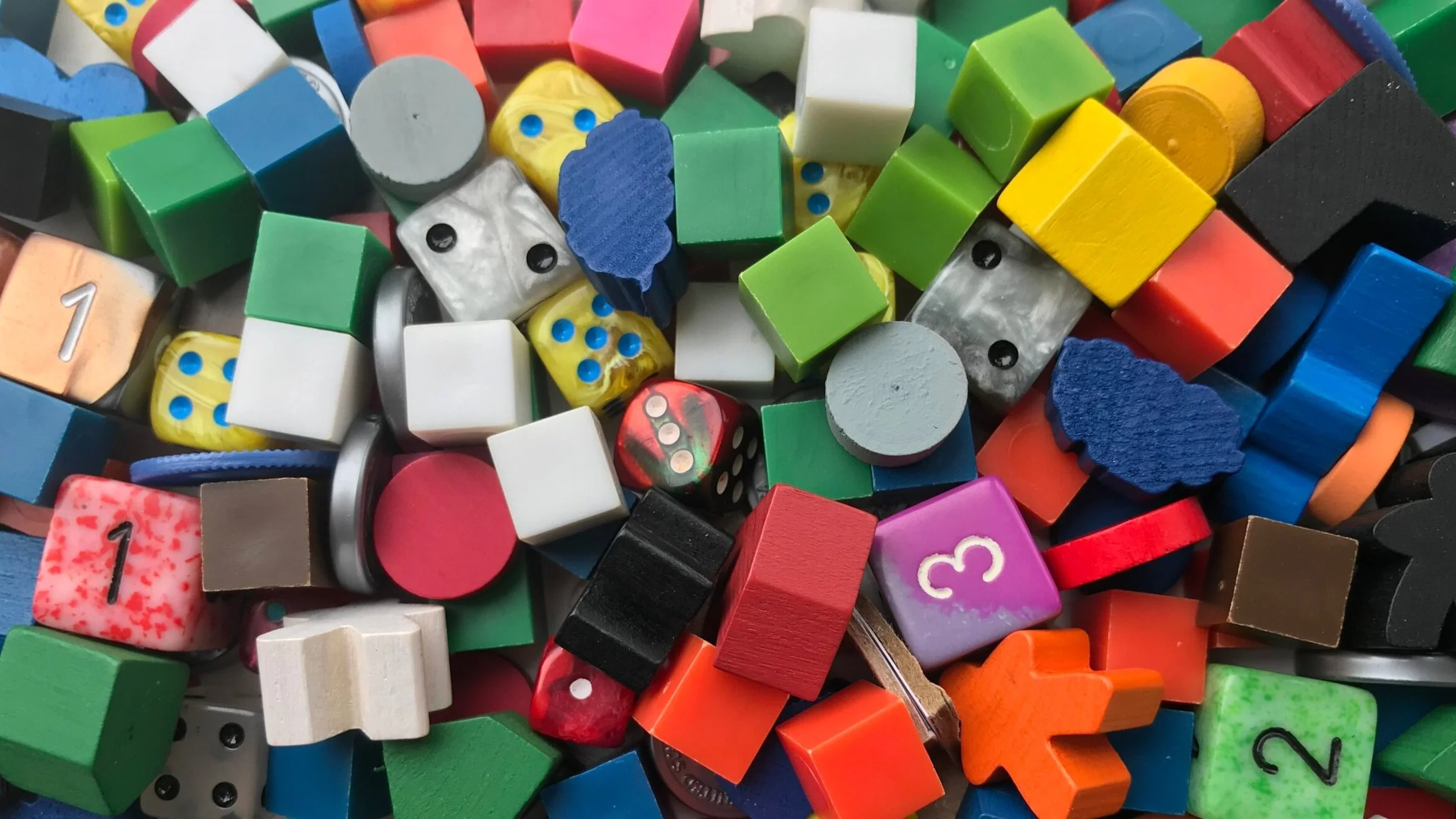Meaningful Decisions: Gil Hova on Design Choices in Battle Merchants
/In our Meaningful Decisions series, we ask designers about the design choices they made while creating their games, and what lessons other designers can take away from those decisions.
In this edition, we talk with Gil Hova, designer of Battle Merchants, about thematic-mechanical fit, scaling, expansions and more.

The Kingdom Cards that give players special abilities and spice up the gameplay all have thematic explanations that fit the world of the game and help make sense of the mechanics. What was your process for coming up with them?
I came up with the base rules of the game, and then looked for rules that players would occasionally want to break. If I had a rule that said “you can’t do X,” then I came up with a card that said “you can do it now.”
Then I had to balance the cards. If a card was too powerful, it was the only interesting decision, and was boring. If it wasn’t powerful enough, no one took it, and that’s boring too. It helped to come up with a baseline of about how much a turn was worth (about $3), and then base each card’s payout off of that.
So we have a card that comes out late that gives you $7 (and remember, most money wins). We have other cards that come out earlier that can give you as much as $12, but they take up a valuable card slot. One card gives you as much as $20, but you may have to spend all your money in order to take advantage of it. It was these interesting choices I was going for.

How can designers learn to use theme to make their games’ mechanisms more intuitive? Are there tricks to the process?
Here’s one tip: avoid flavor text. Seriously. Try to let your players tell your game’s stories entirely through your mechanism.
For example, if you have a card called Space Pirate Attack, and you have a paragraph of flavor text, but its effect is to simply lose a card, then that’s not much of a story you’re telling. On the other hand, if you have a planet in your game where you think the Space Pirates like to congregate, then you can say that the player closest to the Pirate Planet loses two cards. And now you know you’re not just discarding two cards; the Pirates are taking two cards from you in a raid.
Maybe you can then insert a mechanism for another player to raid the Pirates and take those cards! Adding mechanisms for mechanisms’ sake isn’t always the right thing to do, of course, but when a mechanism and a theme are tightly linked, you have a lot more license; players will find those a lot easier to absorb.
Too many designers look at theme and mechanism as opposite ends of a spectrum. It’s not about one or the other in isolation, nor does it matter whether you start with one or the other. The important thing is that you find a good place for them to intersect. The right place might be “nowhere” (as in an abstract game or a word game), but it’s probably going to be somewhere that will let the players tell an interesting story.
And remember: as the designer, you’re not telling the story. You’re just supplying the language. The players will tell the story. If you want to tell a story, write a book.

Some of Battle Merchants’ rules change depending on player count, most notably the double-sided board. Why did you make these changes for different player counts?
I found that the 3-player game needed a smaller board. The board tracks demand, and there are too many spaces to sell to on the 4-player board. The game needed to feel tighter.
That meant a lot of topographical changes. I had to vary the assets players start with in a 3-player game, but I think I did it in as smooth and streamlined a way as possible.
The 2-player game took more work. It was boring at first; one player would get Craft, and the other would get Kingdom Cards, and neither really interacted. I changed the rules for 2 players so that when a player took a Kingdom Card, a Craft Card would get discarded, and vice versa. That shook things up wonderfully, and introduced a great zero-sum element. If I know you want that Craft Card, and it’s linked to a Kingdom Card I want, I can help myself and hurt you in the same move!
I also needed to shrink the board even more, but I couldn’t put a third side on a 2-sided board! And I didn’t want to ask my publisher to make a totally different 2-player board. So I introduced a mechanism called “Salesman Steve” that sells a weapon to the board after each player sale. And again, since Salesman Steve works off an algorithm, you can figure out how to use his sales to best deprive your opponent of demand.
What should designers watch out for to make sure their game scales well?
As a designer, you must pay close attention to how your game plays with different player counts. In Battle Merchants, I needed the game to get tighter with fewer player counts. I didn’t need to change any mechanisms for the 3-player game, but I needed to introduce new rules to make the 2-player game compelling. You might need to do the same thing for your game. Try to make the changes as simple and gentle as possible, but it’s better to have an interesting version of the game with more rules than a boring version of the game with the same rules.
Be mindful of player experience. Look out for downtime. I don’t believe downtime is necessarily a bad thing; in games like Myrmes or Princes of Florence, you’re spending most of your downtime planning out your next move, so in those games, I actually want a bit of time to think!
But if you look at 4-player Ascension or 6-player Alhambra, you can see problems. In those games, it’s not that the downtime is long; it’s that it’s not interesting. The game state changes too much between turns for you to want to pay attention to anything in between. That consequently lengthens the downtime, because players don’t bother planning between turns, and it becomes a vicious cycle.
Also, be forewarned that 2-player games are not at all like games for more players. They’re a completely separate animal. In a game with 3 or more, what I do might help Suzanne but hurt Chris. In a 2-player game, anything that helps me hurts you. It’s completely zero-sum. So mechanisms that rely on other players to force interesting decisions don’t always work with two players. That’s why I needed to make those changes to Battle Merchants.
Consider adding a solo version to your game. The solo community isn’t huge, but they’re very vibrant and vocal, and they can give your game a nice push. I couldn’t find a way to do it in Battle Merchants, but my next game, The Networks, plays very nicely solo.
Also, don’t rush to lock in the rules to your game before exploring how it plays with a bunch of different player counts. You might find a rule that helps the 2-player game also helps the 4-player game. Or, a modification to the 4-player game helps the 2-player game.

Your new expansion to Battle Merchants, New Kingdoms, adds fresh Kingdom Cards to the mix but leaves the rest of the game as it is. What were your goals for the expansion, and why did you focus on the Kingdom Cards?
I was working with a publisher edict: I needed to make the expansion available on DriveThruCards specifically. So I couldn’t change anything that wasn’t on the cards. (I did modify a couple of existing rules, but those are small tweaks.)
I also felt like I could explore some interesting space in the Kingdom Cards. I had been working on an expansion that was tied to the Craft Cards, but when I moved those powers to the Kingdom Cards, it felt a more natural fit.
There were also a few complaints about the base game I wanted to address. First, new players sometimes ran themselves out of money. I had put some money on the Kingdom Cards to help them out, but this wasn’t always an interesting option for them. So for the expansion, I removed a lot of the Kingdom Card money bonuses, and instead included a Tzolk'in-like rule where a player could spend his entire turn going up to 5 coins.
I had some more limitations on that at first (you couldn’t have any forged weapons), but I found I didn’t need that; spending your entire turn just to get a few coins was rarely optimal, and if you kept doing it in the game as late as Autumn, that was a good sign you weren’t having a good game. New players found the game more forgiving this way, and experienced players couldn’t exploit the rule, even after I streamlined it to remove the forged weapons requirement. I was delighted to see it work so well!
Second, while I’m happy with the balance of the original game, there were some cards that bugged me. Instigator was more boring than I expected; I had made a change to it close to finalizing that nerfed it too much, and it wasn’t valuable. Scavenger was balanced in some games but overpowered in others. Desperate Times was an interesting card, but I had an idea of how to make it less fiddly.
Third, I wanted more variety. In the base game, you’ll see almost every Kingdom Card; you may not see some of the later ones if you end the game quickly. I wanted to see if I could come up with a Kingdom Card deck that was bigger, which would let players shuffle out certain cards during setup. This would add some nice variety to the game.
Fourth, players hated asking each other for Craft levels. They kept asking for some kind of Craft Tracker. This was my chance to give them one!
I realized I could address all these points with a single new Kingdom Card deck, plus a couple of rules and a few extra cards. That fit in with my publisher’s edict, and it let me add some new possibilities to the game and address some nagging issues.
What are some ways designers can use an expansion to change up their game?
I’ve found that different people want different things from expansions. Some insist that an expansion must introduce a new mechanism. Others want to see refinements to the base game. Still others want a game that feels different. Still others want the flavor of the original game. And so on.
These are mostly good reasons, other than the “refinements” one. Sadly, I’m a fiddler; I love to tweak my game, no matter how late we are in the process! This caused Minion Games no shortage of angst during Battle Merchants’ production, I’m afraid. So the expansion made my game-tweaking side happy.
That said, it’s quite normal to see a big improvement to your game well after it’s too late to include it in your base game. So an expansion isn’t a bad place to put it. Just don’t make a habit of it, and don’t release base games that are clearly suboptimal or broken!
Cardboard Edison is supported by our patrons on Patreon.
SENIOR INVENTORS: Steven Cole, John du Bois, Richard Durham, Matthew O’Malley, Isaias Vallejo
JUNIOR INVENTORS: Stephen B Davies, Luis Lara, Behrooz Shahriari, Aidan Short, Jay Treat
ASSOCIATES: Robert Booth, Doug Levandowski, Nathan Miller, Marcel Perro
APPRENTICES: Gino Brancazio, Keith Burgun, Kiva Fecteau, Scott Gottreu, JR Honeycutt, Brad Price










